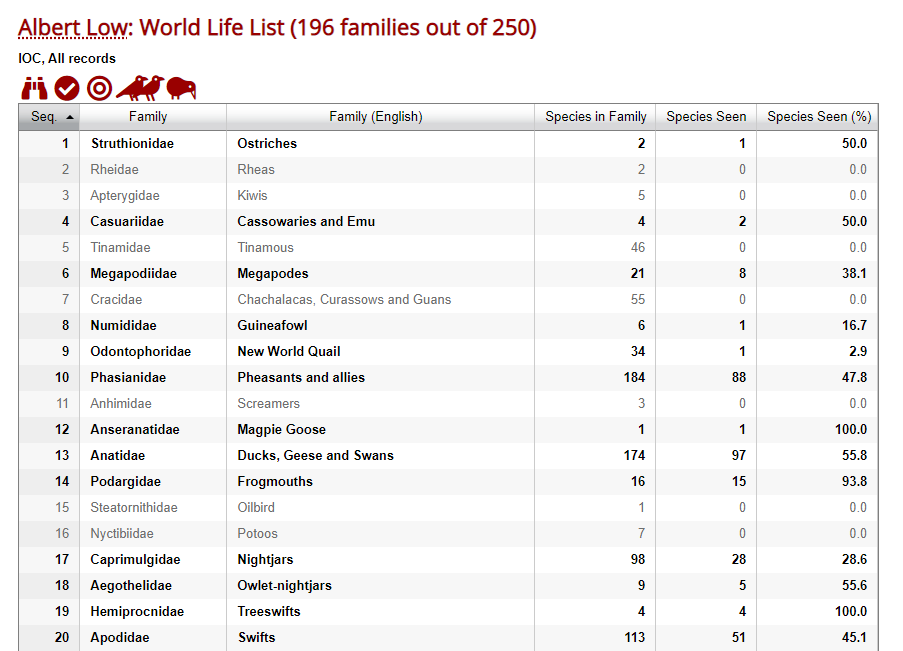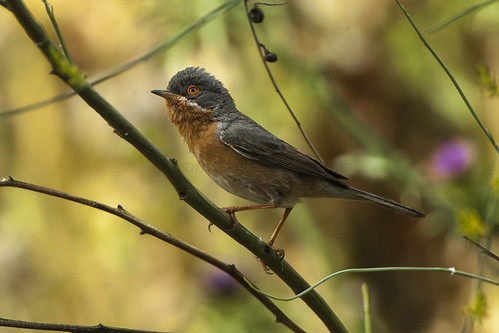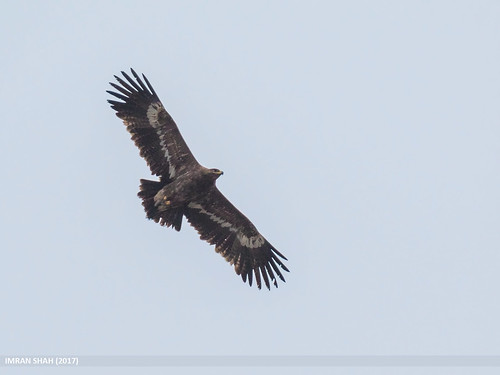BUBO Listing News
The IOC World List has now been updated to the latest published version 11.1.
Many BUBO listers will be affected by the split of Lesser Short-toed Lark Alaudala rufescens into Mediterranean A. rufescens and Turkestan Short-toed Lark A. heinei—if you've seen it in Turkey or further east to Central Asia, as well as in Southern Europe, North Africa or the Middle East, then you'll gain an armchair tick. For those few fortunate enough to have seen the bird at Portland Bill, Dorset, England, in May 1992, we have assumed this to be Mediterranean, pending an official assessment.
Regional or country lists based on IOC, such as the IOC Western Palearctic list, have also been updated.
We automatically apply updates where we can, and in other cases you will be prompted for any taxonomic changes to address yourself.
If you have any queries about distributions or identification of individuals so that you know what you can count, do post in the forums so that other BUBO Listers can help out.
For many birders, seeing as many of the bird families in the world as possible is an interesting quest. For those willing and able to travel, seeing all of the currently 250 families on the IOC world list is a feasible target. We have now made it easy to see which families you have, and haven't, seen on any of your lists. To do so, just click on the two crows icon. Families where you have seen at least one species are shown in bold, and those that you haven't seen in grey. You can also see how many of the species within the family you have seen, and all these columns are sortable.
Target Families
You can also see your "target" families, i.e. those families you still need, ranked by "easiness". This is determined in a similar way to target species, i.e. the easiest target family is the one that has been seen by most other listers, for the same location, time period, taxonomic authority and list type. Sort the family table by either of the last two columns ("Seen by Others" and "Others %") to order by the number of other listers who have seen at least one species from the family. (NB: For simplicity, these columns are not shown in the example above.)
Because target families can be quite slow for popular and large lists, e.g. World lists, they are not shown by default. When viewing your families as above, click the two crows again (there will now be a target symbol superimposed on them) to add the targets columns to the end of table.
For those keen on building a big world family list, you can follow BirdQuest's strategy for seeing all the world's bird families!
The IOC World List has now been updated to the latest published version 10.2 from July 2020.
Of most interest to listers in Britain and Europe will be the split of Subalpine Warbler (have you seen Western or Eastern or both?!) Most American listers will have lost Northwestern Crow following its not unexpected lump with American Crow, whilst some Asian listers will be pleased that White-faced Plover is a separate species compared to Kentish Plover. Australian listers might find they now have one or two extra Grasswrens following the split of Striated.
Regional or country lists based on IOC, such as the IOC Western Palearctic list, have also been updated.
We automatically apply updates where we can, and in other cases you will be prompted for any taxonomic changes to address yourself.
If you have any queries about distributions or identification of individuals so that you know what you can count, do post in the forums so that other BUBO Listers can help out.
As well as the recently introduced Lockdown Listing, there are many other types of lists that birders like to keep. We support lots of these on BUBO Listing, some more frivolous than others!
| All records | Any (wild) bird. The default list type. |
| Self-found records | Birds you have found yourself, e.g. not twitched. We don't enforce rules for what exactly is meant by self-found: it has often been discussed - e.g. on the BUBO Forum, and see Punkbirder rules - and easily gets controversial! E.g. what if you are in a group, what if you re-find a bird that was missing? Decide on your own rules and use the comments when you enter a record on your list. |
| Garden | Birds seen in or from your garden or yard. Read more about Garden/Yard Lists. |
| Green: foot | Also known as zero-carbon lists, or BIGBYs (Big Green Big Year), all birds recorded must be whilst walking from your home or place of work. Read more about Green Birding in general from the Biking Birder and Green Birding Megastars. |
| Green: non-motorised | Still green, but also allowing forms of non-motorised transport (e.g. bicycle, canoe). |
| Green: public transport | Not quite as green, but allowing scheduled public transport (ground or water only, so no planes). |
| Patchwork Challenge | Birds on your local patch as part of Patchwork Challenge. |
| #LocalPatch | Birds on your local patch as part of #LocalBigYear. |
| Lockdown: COVID-19 | Birds seen during lockdown because of COVID-19. Also consider the related Facebook groups #BirdTheFeckAtHome and The Self Isolating Bird Club. |
| Winter | Birds seen during the winter season (December to February) |
| Nocmig (Night Flight Call) | Nocturnal bird migration recording, i.e. bird calls recorded by 'nocmigging'. |
| Photographic |
Birds that you have photographed (and ideally have an identifiable photo!) |
| Audio | Birds that you have sound recorded (identifiably!) |
| Ringing/Banding | Birds that you have ringed (banded). |
| Nest | Nests seen. |
| Juvenile | Birds seen in juvenile plumage, i.e. out of the nest but prior to moult into first-winter plumage. |
| Television | Birds seen or heard on TV. Read more about Television Lists! |
| False | Birds recorded anywhere in the world, i.e. not just within the actual list location. Hence a False Western Palearctic list includes species that have been recorded in the Western Palearctic and which you have seen anywhere in the world. |
All these different list types are in addition to the actual location, authority used, and whether it is a life list or year list, so you can have a self-found life list for your local patch, multiple garden lists for different places you have lived, a county green (non-motorised) year list, and a country false life list, for example.
You can show all lists within an area, whether they are for the full county itself or a more specific site, within it. For example, you can see all Ireland self-found country lists, or show the same and include all Ireland self-found site lists as well. Just ensure you 'show all sublocations as well' when you choose a list to view.
With a quarter of the world in lockdown because of the COVID-19 coronavirus, there clearly isn't much birding being done. Many of us are birding more regularly from our gardens, houses or apartments, or wherever else we are in lockdown, so we have just introduced lockdown lists to BUBO Listing. When you create a new list, choose 'Lockdown: COVID-19' from the list type dropdown.
Rather than need to add a specific site for where you are locked down, we suggest you add it to the county (or country). You can show all lists within the county, whether they are for the full county itself or a more specific site, even garden, within it: just ensure you 'show all sublocations as well' when you choose a list to view. You can do this for any list, e.g. year, life, self-found etc. Be sure to select list type of 'Lockdown: COVID-19' to see all lockdown lists within the selected location. For example, see all England lockdown lists.
Finally, please be sensible during this period of global crisis. Follow official advice, and stay at home.







